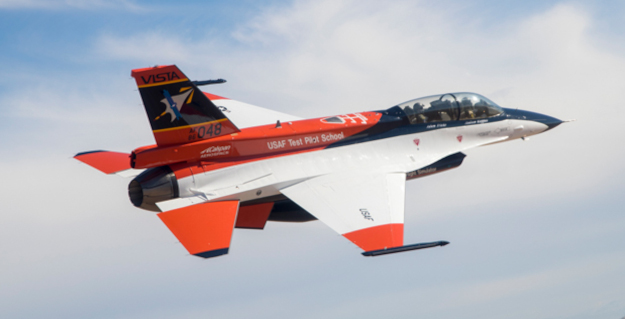
DARPA-developed AI successfully pilots fighter jet
By DE Staff
General DefenseAgency’s ACE Program completes first flight tests of air combat AI algorithms on modified F-16.

The Variable In-flight Simulator Aircraft (VISTA), a modified F-16 piloted by DARPA developed AI, flying over Edwards Air Force Base.
(Photo credit: DARPA/Air Force photo by Christian Turner)
DARPA announced that its artificial intelligence algorithms, developed under the agency’s Air Combat Evolution (ACE) program, have successfully piloted a physical F-16 in flight. Begun in 2019, the ACE program aims to enable autonomous, AI-driven air combat using human-machine collaborative dogfighting.
In August 2020, the ACE program’s AlphaDogfight Trials pitted AI algorithms against each other flying simulated F-16s in a virtual dogfighting competition. The winning AI was then pitted against and defeated an experienced F-16 fighter pilot flying in a simulator.
In December 2022, however, the previously computer simulation-bound dogfight AI algorithms were uploaded to a modified F-16 test aircraft, named the X-62A or VISTA (Variable In-flight Simulator Test Aircraft),.
During the test, DARPA says the F-16 flew multiple flights over several days at the Air Force Test Pilot School (TPS) within Edwards Air Force Base in California. According to US military research agency said, the flights successfully demonstrated that AI agents can control a full-scale fighter jet and provide live-flight data.
“Thanks to the outstanding teamwork and coordination between DARPA, the Air Force Test Pilot School, the Air Force Research Laboratory and our performer teams, we’ve made rapid progress in Phase 2 across all areas of the ACE program,” said Air Force Lt. Col. Ryan “Hal” Hefron, the DARPA program manager for ACE. “VISTA allowed us to streamline the program by skipping the planned subscale phase and proceeding directly to a full-scale implementation, saving a year or more and providing performance feedback under real flight conditions.”
The X-62A/ VISTA aircraft is a highly modified, two-seat F-16 that can be programmed to model the flight-handling characteristics of different aircraft, DARPA said. It was also upgraded to include the System for Autonomous Control of Simulation (SACS), making it a suitable to test ACE’s autonomous F-16 AI agents, although a human pilot was on board as a failsafe. DARPA said AI contributors, including EpiSci, PhysicsAI, Shield AI, and the Johns Hopkins Applied Physics Laboratory, flew different F-16 AI algorithms on the X-62A.
“We conducted multiple sorties [takeoffs and landings] with numerous test points performed on each sortie to test the algorithms under varying starting conditions, against various simulated adversaries, and with simulated weapons capabilities,” Hefron said. “We didn’t run into any major issues but did encounter some differences compared to simulation-based results, which is to be expected when transitioning from virtual to live. This highlights the importance of not only flight testing advanced autonomous capabilities but doing so on testbeds like VISTA, which allowed us to rapidly learn lessons and iterate at a much faster rate than with other air vehicles.”
www.darpa.mil
